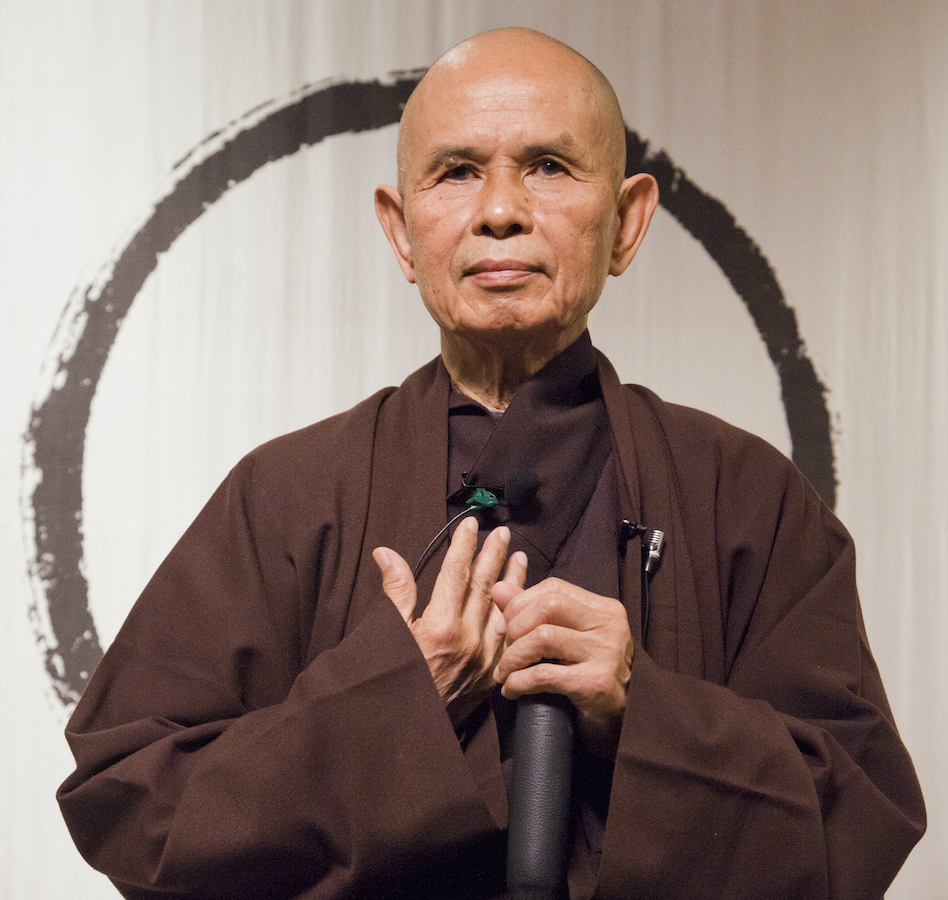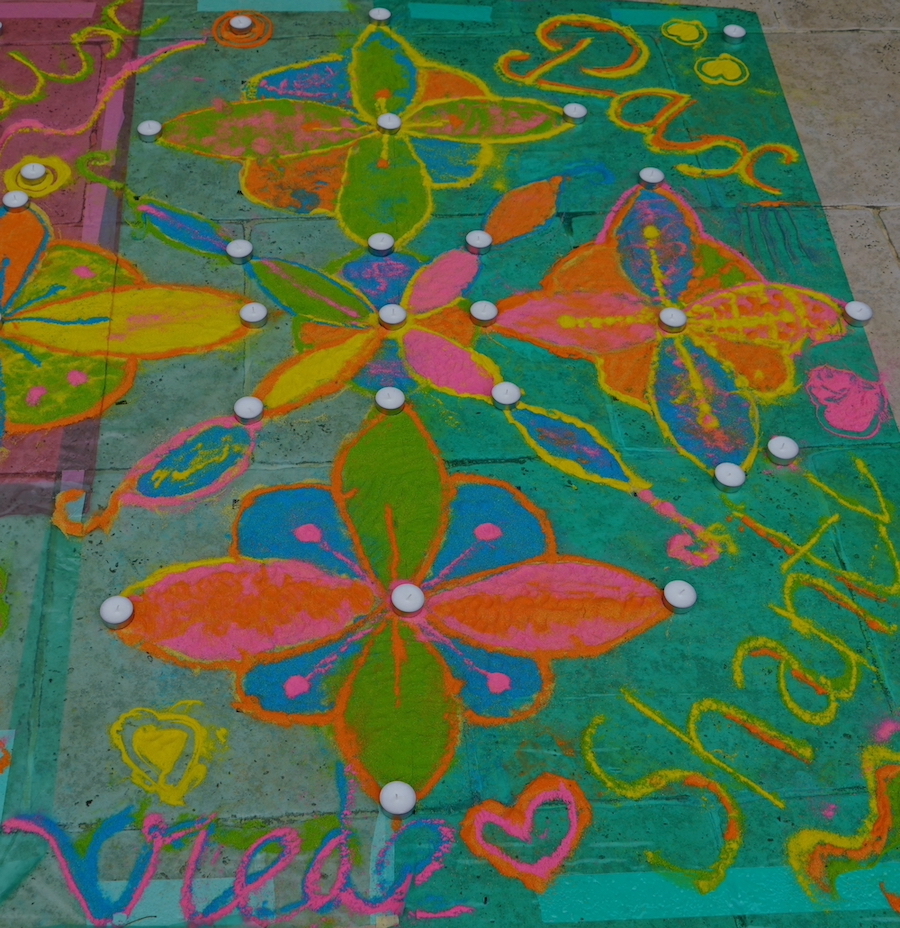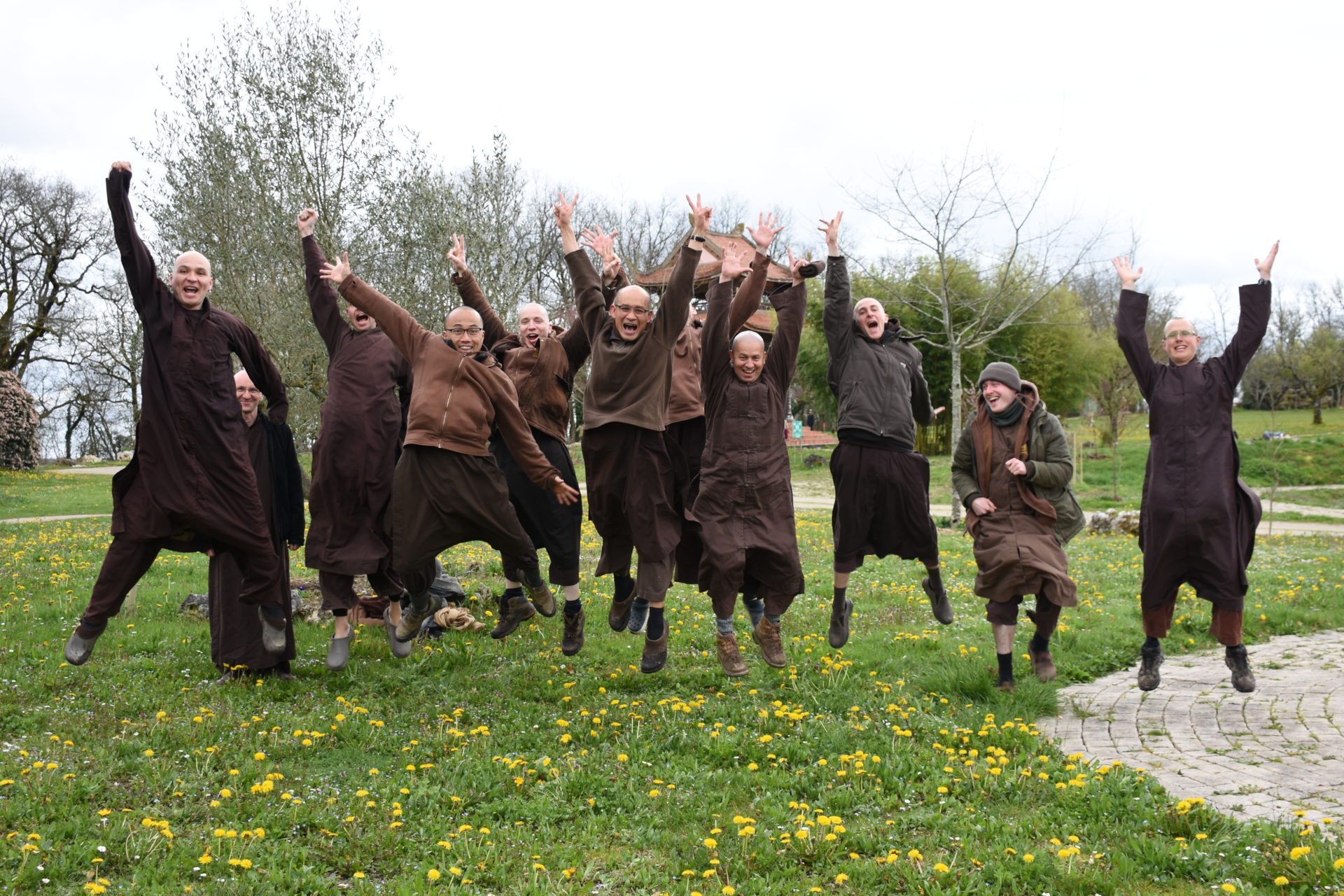
New Hamlet, Plum Village
November 1, 2012
Good morning, dear Sangha.
Today is the first of November in the year 2012, and we are in the Full Moon Meditation Hall in the New Hamlet of Plum Village. This is the fourth and last week of our Autumn Retreat. This is the eighth Dharma talk.

New Hamlet, Plum Village
November 1, 2012
Good morning, dear Sangha.
Today is the first of November in the year 2012, and we are in the Full Moon Meditation Hall in the New Hamlet of Plum Village. This is the fourth and last week of our Autumn Retreat. This is the eighth Dharma talk.
During this fall retreat, we have learned many things. We have learned how to take care of our body and our feelings; how to generate feelings of joy and happiness; how to go back to ourselves and embrace the pain and suffering within ourselves, and to understand the roots of that suffering. We have learned how to look at the other person so we can see the suffering in him or in her and help that person transform. And we have learned how to listen with compassion to ourselves and to the other person in order to restore communication and bring about reconciliation and peace. We have learned the Sixteen Exercises of Mindful Breathing to help us do these things successfully. We have learned about the path leading to the cessation of suffering—the path that leads to joy and happiness.
We have learned about the Five Mindfulness Trainings, and many of us have received and committed to practice them. We know that the five trainings are a concrete expression of the practice of mindfulness. They are based on a kind of wisdom—a kind of insight called Right View—free of all kinds of discrimination and separation and complexes, free of fear and anger.
Signlessness
Today, we will look more deeply into the nature of our birth and our death. As we sit here, we can hear the rain falling. The clouds are dying so the rain can be born, and the rain is teaching us about the nature of no birth and no death. In Plum Village, we say that it is impossible for a cloud to die. I know a painter who only paints clouds. He spends a lot of time contemplating the clouds, and he draws clouds beautifully. You recognize a cloud because the cloud has a form—an appearance. Without an appearance, a mark, or a sign, it is difficult for us to recognize something.
Sometimes the cloud is there, but we cannot recognize her. Suppose you look into this Dharma hall: you don’t see a cloud, but, in fact, there is a cloud here. There is water vapor in our in-breath and our out-breath, and that is the substance of a cloud. When we are breathing in and breathing out, we contribute to the making of that cloud. When the water vapor in the air comes in contact with something cold, it appears as a cloud. Right now, because it’s not cold enough in the hall, we don’t see the cloud; it is invisible. When something is invisible, we tend to think of it as non-existing, and that is the fault of our perception. We are fooled by our perceptions.
Suppose wind is blowing towards a mountain. The wind is the air moving, and when the air meets the mountain it flows upwards. As it rises, it encounters the cold, and that’s why it appears as a cloud. Down here it is not visible, but higher up it is visible. Let us not say there is a cloud up there, but there is no cloud down here. We have to be careful. We have to learn to look at things with the eyes of signlessness—the eyes of marklessness. A meditation practitioner should try to use her eyes of signlessness to look at things.
When someone who is close to you has just died, you don’t see him or her anymore in the same appearance, and you cry. But if you have the eyes of signlessness, you can see the continuation of your loved one in other forms. It’s like the rain, which is a new form of the cloud. If you cry because your beloved cloud is no longer there, you are caught in a sign, a mark, or an appearance. Your sorrow, your anguish, or your despair is born from that kind of perception. You think that your beloved one is no longer there, but he or she is still there in other forms, like the cloud is still there in the form of rain. The rain is calling you, “Darling! Darling! I’m here. In this direction. Don’t you see me?” If you have eyes of signlessness, you can recognize your beloved cloud in her new form—the rain. And you can be in touch, right here, right now. This is called the Meditation on Signlessness, using the eyes of wisdom.
Let us contemplate our cloud up in the sky. Part of our cloud is slowly becoming rain. When we say that a cloud is dying, it means a cloud is becoming rain: not dying, just becoming. In the teaching of the Buddha, “to be” means “to become.” You cannot always be the same thing; you are always becoming. To be means to become because the nature of everything is changing. When you look at a picture of yourself as a five-year-old, you see you are no longer that little child. You have grown to be a lady or a gentleman, and you are so different. So, instead of saying “I am” you say, “I become.”
It takes time to become. A cloud becomes rain, and then the rain becomes a river. The rain is dying so it can become the river. The rain has stopped, but that does not mean the rain is no longer there. If it is impossible for a cloud to die, then it is impossible for the rain to die. The rain cannot die. The rain can only take another form and become a river, or snow, or ice.
Continuation
To be means to become. To die means to continue, and to be born also means to continue. The cloud continues as rain, and the death of the cloud means the birth of the rain. If the cloud could sing “Happy Birthday,” then the cloud could also sing “Happy Death Day,” because it’s not sorrowful to become the rain. To be a cloud, floating up there is wonderful; but to become rain is also wonderful. A happy death is possible if you see death only as a continuation. I am a cloud and I am happily becoming the rain. I’m not afraid of becoming the rain. I cannot die; I can only become.
In our human mind we think that to be born means from nothing you become something, from no one you become someone, but that goes against the evidence. From nothing you cannot become something. From no one you cannot become someone. Do you think that this cloud has come from nothing? No. It has come from water vapor. That is why the birth of the cloud is also the continuation of the cloud from something. So, water vapor becomes cloud; cloud becomes rain; rain becomes river, and the river gives birth to water vapor.
We know that before expressing herself as a cloud, the cloud had been water vapor, generated from the water in the ocean and the lakes and the heat from the sun. Body and mind are like that too. When you do not see body and mind anymore, you think that body and mind are dead. But that is wrong because nothing can die. If a cloud can never die, your body and mind cannot die either.
Scientists have found out that nothing can die. The first law of thermodynamics is conservation of matter and energy. It says that you cannot create new matter or new energy. You cannot destroy matter; you can only convert matter into energy. You can convert one form of energy to another form, but you cannot destroy it. The nature of energy is the nature of no birth and no death, and the nature of the cloud is also the nature of no birth and no death. How can your body-mind die? If you have the eyes of signlessness, you can see the continuation of your body-mind.
You cannot say that there is no cloud in this Dharma hall. There is a big cloud here, a collective cloud. Every one of us contributes to making the cloud here in this hall. If it were very cold outside, then the air inside would become visible on the windows and we could see the cloud forming. There is the water vapor which becomes the cloud; there is the cloud which becomes the rain; there is the rain which becomes the river or the ocean, and the river and ocean become water vapor again. That is samsara—nothing is lost, nothing is born, nothing dies. The practice of meditation ultimately helps us touch that nature of no birth and no death of the cloud, of everything.
Birth and death are notions created by our mind. They cannot be applied to reality, and science has begun to see that. The scientist Anton Lavoisier said that nothing is born, nothing dies. He meditated in his own way. He looked around at energy and matter; and he also discovered the nature of no birth and no death of matter and energy. If we touch the nature of no birth and no death in ourselves and in the other person, then we are free from grief, sorrow, and despair. Darling, I know you are still here, and I will look for you with the eyes of signlessness; I recognize you in your wonderful new form, your new appearance.

Developing Right View
A drawing of a single cloud is not perfect because it is a closed circle; it might be caught in an idea of a self—that there is a self that continues always in different forms. But while becoming rain, our cloud has joined other clouds. Action can be collective or individual. When we set up a Sangha—a practice center to support the practice of a group of people—that action is a collective action. When the action is collective, the fruit of that action is also collective, because not only do we profit but many others also profit from the practice center or the Sangha. And that is why in Buddhism the notion of action is very important.
Action in Sanskrit is karma. And karma is thought, speech, and bodily action. A thought is the basic action. Suppose you produce a thought of anger, of hate, of despair: that thought begins to have an effect on your body and your mind right away. It destroys your body; it harms your mind because you are intoxicated by that thought of anger, fear, despair, or hate. It’s not good for your health; it’s not good for the health of the world. Producing a thought is the first action; that is why a practitioner, after having produced a thought, becomes aware of that thought: “This is not a good thought; this is a thought that can destroy my body and my mind and the world. I don’t want to produce such a thought.” That is mindfulness. “I want to produce the opposite kind of thought. I want to produce a thought of tolerance, compassion, understanding, or forgiveness because such a thought will help heal my body, my mind, and the world.” With mindfulness we can recognize our thoughts and decide to produce thoughts in such a way that healing, nourishment, and reconciliation are possible. That is the first aspect of our action.
In order to produce such thoughts, we need to have Right View or Right Understanding. Without Right Understanding, we have a lot of discrimination, fear, and anger; we cannot produce thoughts of compassion, understanding, and love. In order to have Right View, we have to practice Right Mindfulness and Right Concentration. With the practice of mindfulness and concentration, we can gain Right View, Right Understanding, and we can remove all kinds of wrong views and discrimination. On that basis we can easily produce Right Thinking, which can promote more understanding and compassion and can express the insight of nondiscrimination.
If we have Right View or Right Understanding, then everything we do with our body will be Right Action. We have the power to support, protect, save, help, and rescue and that is good for ourselves and good for the world. Right View is the foundation of Right Thinking, Right Speech, and Right Action. And Right View is attained by the practice of mindfulness and concentration. Signlessness is a practice of samadhi, and samadhi is a practice of concentration. You need mindfulness to make your concentration strong. There are many practices of concentration and signlessness, not just one. Signlessness is available in every school of Buddhism; it is one of the three doors of liberation.
We are made of mind and body, and we know that mind and body inter-are. Without mind, the body is a dead body. Without body, the mind cannot operate. So, you cannot take body out of mind or mind out of body. Like the left and the right, you cannot take them apart. When you do not see body and mind, don’t say that someone is no longer there. They are in their new manifestation. How do you know that? You don’t see them, but they are still there through their action. They have produced thoughts, speech, and bodily action, and these are their continuation. It’s like the cloud that has produced rain as its continuation. You don’t see the cloud anymore, but it is still there in a new form.
So, if you don’t see the mind-body of your beloved one, don’t say he is no longer there. You have to look for his continuation in you and around you. When the rain stops, you don’t say the rain has died. The rain has not died; she is in her new form of the rivers or the oceans. When you look carefully, you see that the rivers and the oceans are becoming water vapor, which is producing clouds again. The water vapor does not come only from this river; it comes from many rivers and many oceans. You are not in a closed circle. There’s no separate self. If we take into account the input and output, we are free from the notion of a cloud as a separate self.
Every thought we produce, everything we say, and every act we undertake is our continuation. Even if we can’t see your body-mind anymore, you continue always through your actions. You are your actions. Jean-Paul Sartre says that man is the totality of his action. Man is his karma. He’s not body and mind. Body and mind might vanish, but his action continues always. After the dissolution of this body and mind, you continue through your actions, both good and bad. You have the power to make sure that your action and your continuation will be good. Produce only good thoughts; produce only good speech; produce only good action, and you are assured a good continuation. Even with the dissolution of this body, you cannot die; you always continue because you are your action.
Look at the Buddha: he always continues. When we sit together and breathe, and experience calm, serenity, and peace, this is the continuation of the Buddha. The action of the Buddha continues, and the Buddha is accessible in the here and the now. If you are caught by the sign of the Buddha two thousand six hundred years ago, you lose the Buddha because the nature of the Buddha is signlessness. If you have the eyes of signlessness, you can see the Buddha in the here and the now, in yourself, very close.


